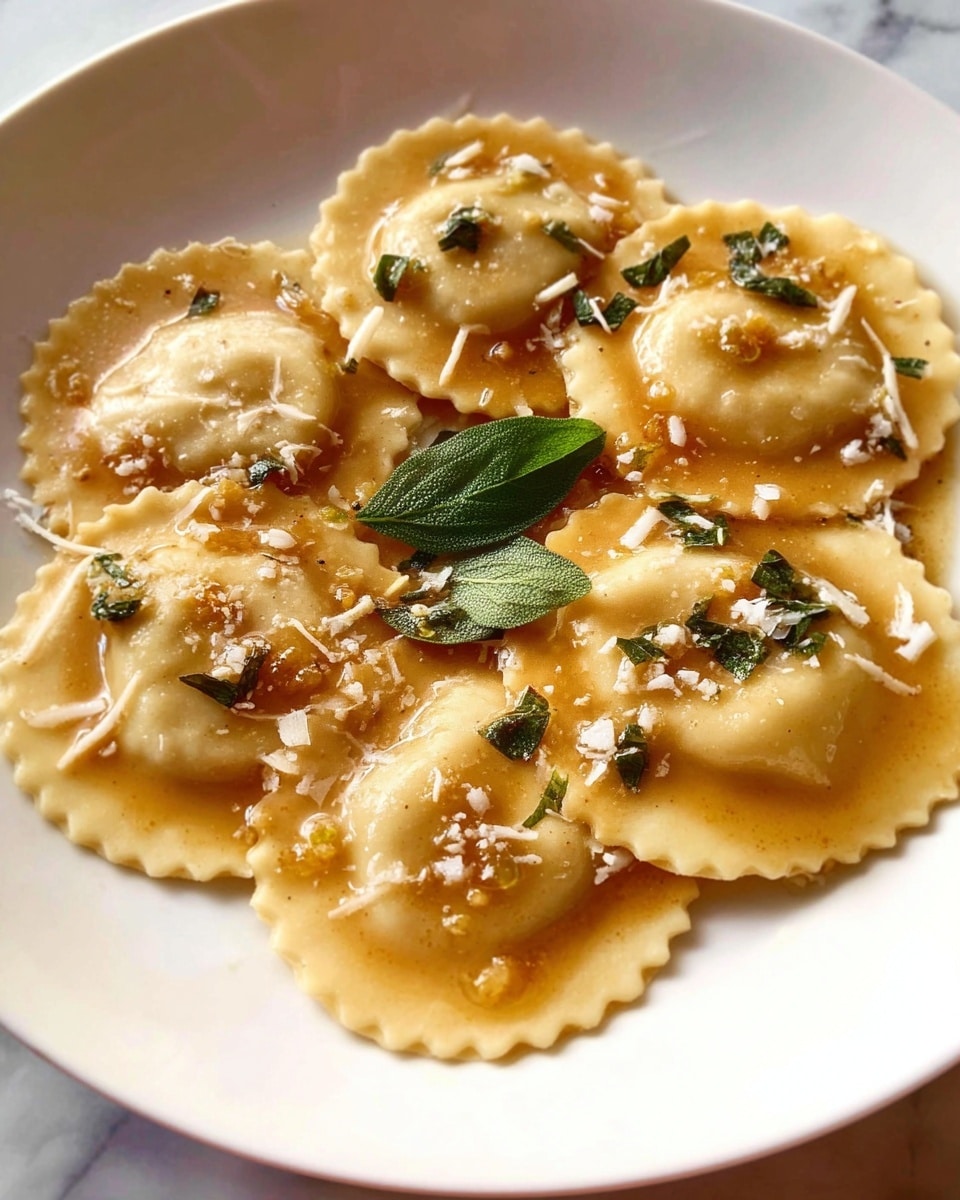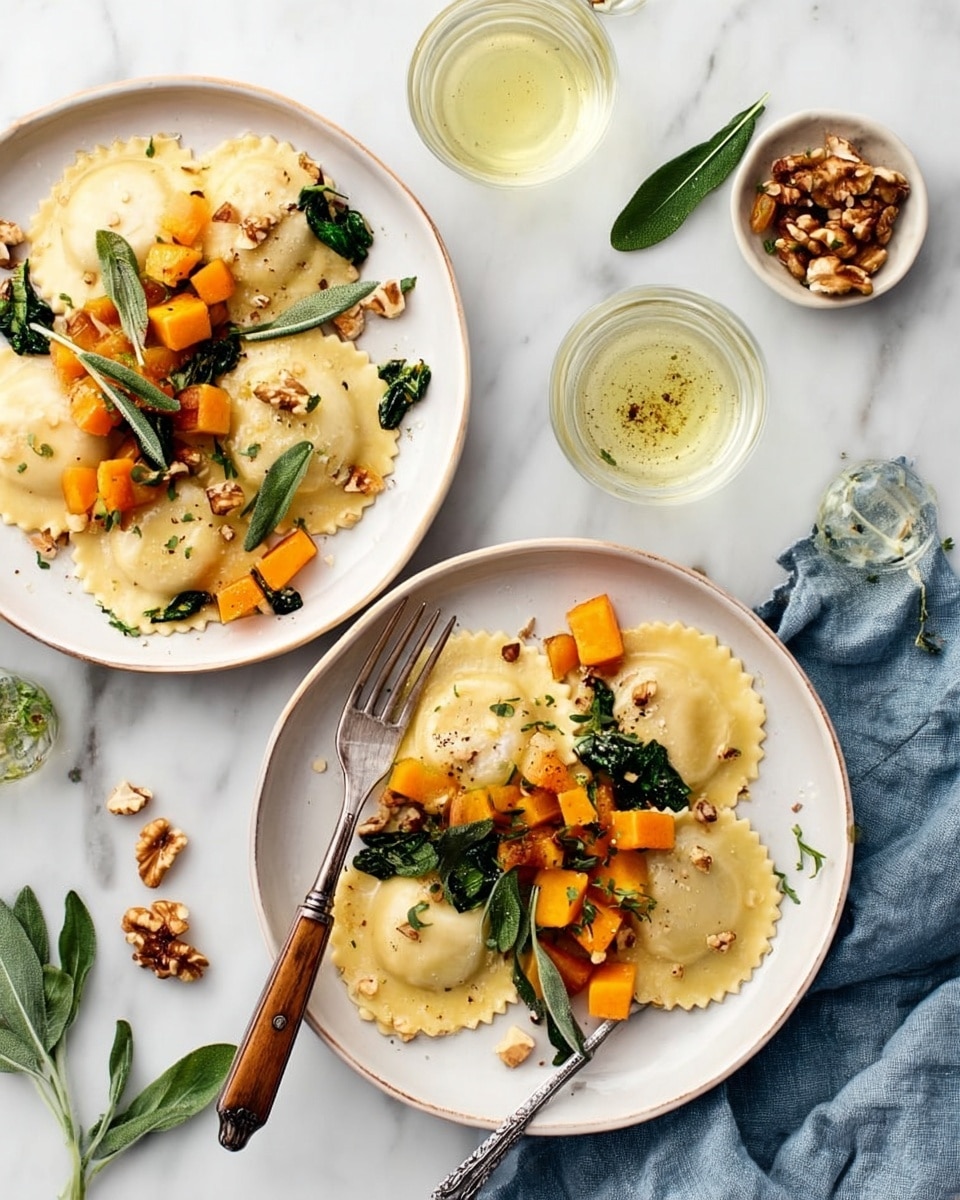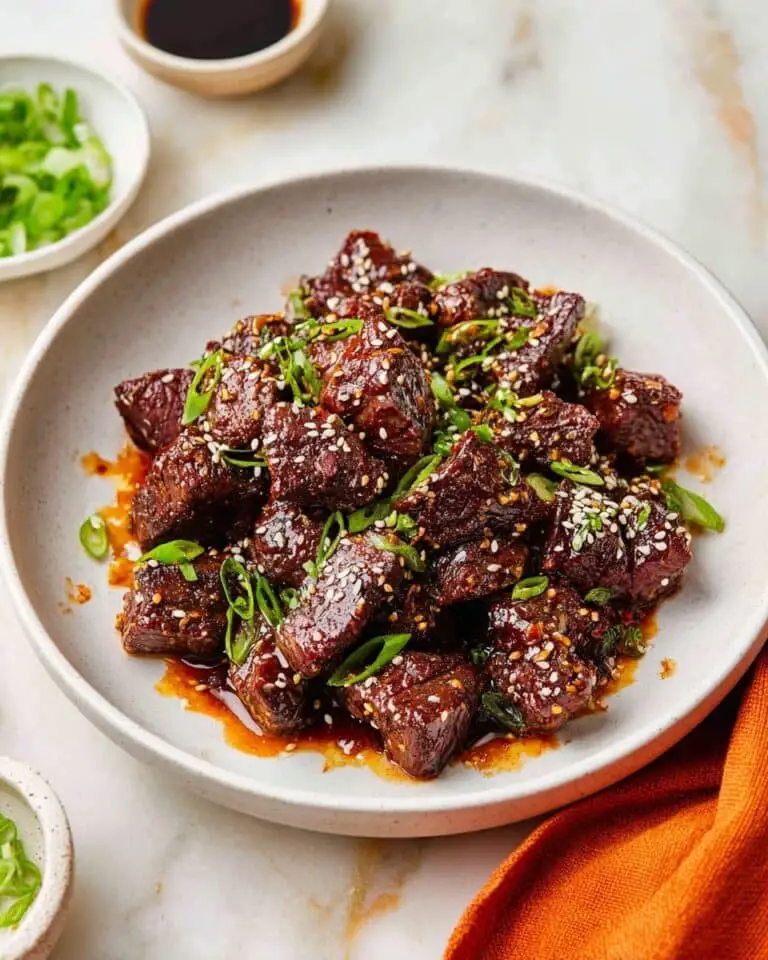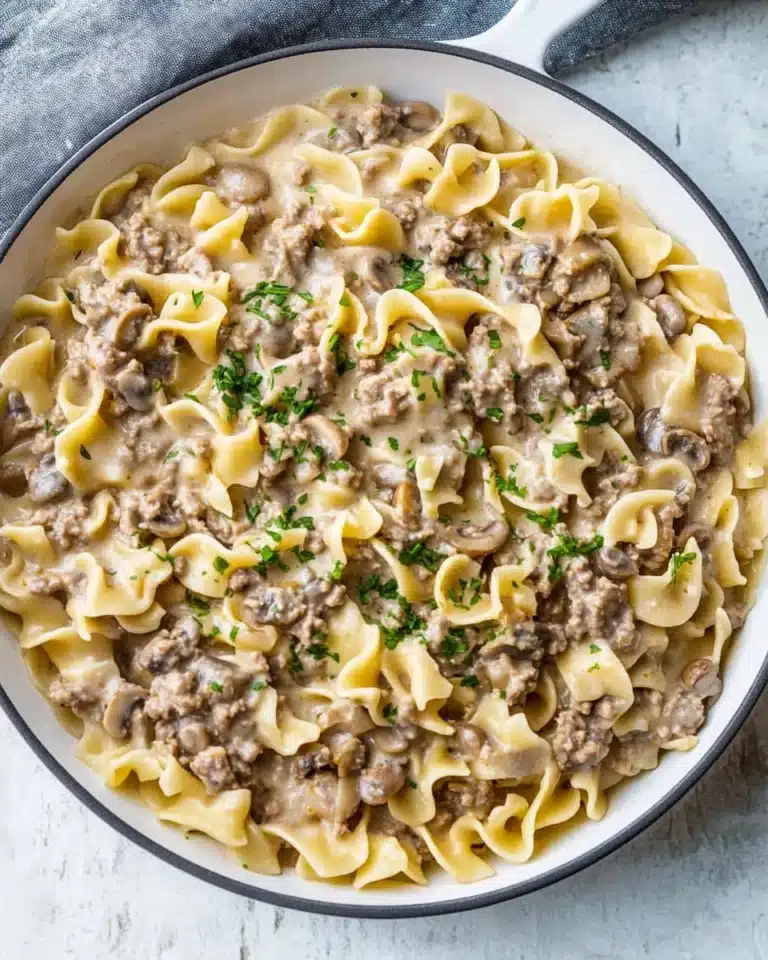I absolutely love how comforting and elegant this Butternut Squash Ravioli with Sage Walnut Filling and Wine Sauce Recipe turns out every time I make it. There’s just something so satisfying about crafting homemade pasta pockets filled with that sweet, earthy butternut squash, perfectly complemented by the fragrant sage and crunchy walnuts. If you’re looking for a dish that’s impressive enough for guests yet cozy enough for a family dinner, this one hits the mark.
When I first tried this recipe, I struggled a bit with the delicate balance of flavors and keeping the ravioli intact during cooking. But over time, I discovered some great tricks—like roasting the shallots and sage together with the squash and using apple cider vinegar to brighten the filling—that really lift the dish to another level. You’ll find that this Butternut Squash Ravioli with Sage Walnut Filling and Wine Sauce Recipe isn’t just delicious, it’s surprisingly doable if you follow along carefully.
Why You’ll Love This Recipe
- Balanced Flavors: The sweet butternut squash pairs perfectly with the savory sage and crunchy walnuts for a well-rounded filling.
- Homemade Pasta Magic: Rolling your own pasta adds a tender texture that elevates the entire dish beyond store-bought noodles.
- Impressively Simple: Despite its gourmet feel, the recipe is approachable with tips to help you nail each step.
- Versatile Sauce: The white wine and sage sauce is light but flavorful, complementing the ravioli without overpowering it.
Ingredients You’ll Need
The ingredients for this Butternut Squash Ravioli with Sage Walnut Filling and Wine Sauce Recipe come together beautifully to create layers of flavor and texture. I recommend looking for a fresh, firm butternut squash and fragrant fresh sage to get the best results.
- Butternut squash: Pick one that feels heavy for its size with smooth skin for sweeter flesh.
- Extra-virgin olive oil: Use a good-quality oil to drizzle for roasting and sauce to add richness.
- Shallot: Adds mild sweetness and depth; roughly chopped to roast evenly.
- Garlic cloves: Both for the filling and the sauce, roasting mellows garlic’s sharpness perfectly.
- Fresh sage leaves: Essential for that signature herbal aroma and flavor, don’t skip fresh!
- Homemade pasta dough: Making fresh pasta really makes the dish stand out; you’ll get the recipe tips below.
- Chopped walnuts: Toasted walnuts give crunch and subtle bitterness balancing the sweet squash.
- Apple cider vinegar: Just a touch adds brightness and cuts through the richness.
- Nutmeg: Warms up the filling with earthy spice complementing the squash.
- Sea salt and freshly ground black pepper: Season to taste, essential for pulling all flavors together.
- Dry white wine: Creates a delicate, aromatic sauce base that lifts the ravioli.
- Fresh thyme leaves: Adds subtle herbal notes to the sauce.
- Optional add-ins: Roasted butternut cubes, sautéed kale, and grated pecorino cheese for extra layers and texture.
Variations
I love encouraging people to make this Butternut Squash Ravioli with Sage Walnut Filling and Wine Sauce Recipe their own. The filling and sauce are flexible, so don’t hesitate to experiment with textures and flavors depending on your pantry and preferences.
- Vegetarian & Nut-Free: I once swapped walnuts for toasted pumpkin seeds to avoid nuts, and it worked great with the sage flavor still shining through.
- Cheesy Variation: Adding ricotta to the squash filling can make the ravioli even creamier—perfect if you prefer a softer texture.
- Seasonal Twist: Swap fresh sage for rosemary or thyme in the filling and sauce during winter for a different herbal note.
- Gluten-Free: While homemade pasta is my favorite, using gluten-free fresh pasta sheets makes this recipe accessible without losing the fresh pasta feel.
How to Make Butternut Squash Ravioli with Sage Walnut Filling and Wine Sauce Recipe
Step 1: Roast the Butternut Squash and Aromatics
Start by preheating your oven to 400°F and lining a baking sheet with parchment paper. Cut the butternut squash in half vertically and scoop out the seeds—this part is so satisfying once you get the hang of it! Drizzle the cut side with olive oil, sprinkle with salt and pepper, and place cut-side down on the sheet. Don’t forget to prick the skin a few times with a fork to help it cook evenly. Pop it in the oven for about 40 minutes until it’s soft and caramelized.
At the same time, take your shallots, garlic cloves, and fresh sage leaves and wrap them up in a little foil pouch with a drizzle of olive oil and a pinch of salt. This foil packet goes on the oven too, but for just 20 minutes. Roasting these aromatics mellows their flavor and adds incredible depth to your filling. Let everything cool for at least 30 minutes before you move on.
Step 2: Make Your Pasta Dough and Rest
While your squash and aromatics cool, it’s pasta time. I follow a reliable homemade pasta dough recipe—it’s easier than it sounds and totally worth the extra effort. Once your dough ball is ready, wrap it tightly in plastic wrap and let it rest for about 30 minutes. This resting time relaxes the gluten and makes rolling out much smoother later on.
Step 3: Prepare the Sage Walnut Filling
Once your squash mixture has cooled, scoop out 1½ packed cups of flesh into a food processor. Add the roasted shallot, garlic, and sage along with finely ground walnuts, apple cider vinegar, a pinch of nutmeg, salt, and plenty of black pepper. Pulse until you get a smooth, velvety filling. Don’t rush here—taste it and tweak the seasoning to your liking. Then pop the filling into the fridge to chill while you prep the pasta sheets.
Step 4: Roll and Assemble the Ravioli
Roll your pasta dough into thin sheets, flouring the surface well to prevent sticking. Lay out four sheets: two for the bottom and two for the top layers of ravioli. Use a tablespoon or a small cookie scoop to dollop the filling evenly spaced on two sheets. Then, carefully cover each with the remaining sheets, pressing gently around each mound to seal out air bubbles. Here’s a tip: dampen the edges with a little water if your dough feels too dry to stick easily.
Use a ravioli stamp or cutter to cut out your shapes and place them on a floured tray while you bring a pot of salted water to a boil. They’ll cook quickly, about 4 minutes, so plan to drop them in when you start your sauce.
Step 5: Whip Up the Wine and Sage Sauce
In a skillet over medium heat, warm extra-virgin olive oil and add sliced garlic cloves and fresh sage leaves. Cook gently for about 3 minutes to infuse the oil with those fantastic savory aromas without burning the garlic. Then pour in dry white wine, sprinkle in fresh thyme and a pinch of salt, and stir for another 2 minutes until the sauce reduces slightly. It’s light and elegant—not heavy or overpowering, but just right to dress your ravioli.
Step 6: Serve and Garnish
Use a slotted spoon to transfer the cooked ravioli to your plates and spoon over that fragrant wine sauce. Sprinkle chopped toasted walnuts and fresh black pepper on top, and if you’re feeling indulgent, add roasted butternut squash cubes, sautéed kale, or generous shavings of pecorino cheese. This combination gives the plate vibrant color, extra texture, and richness that my family goes crazy for every time.
Pro Tips for Making Butternut Squash Ravioli with Sage Walnut Filling and Wine Sauce Recipe
- Roast Everything Together: Roasting the shallots, garlic, and sage along with the squash really deepens the flavor of the filling, making it more complex and delicious.
- Keep Pasta Sheets Floured: Dust the pasta sheets generously with flour to prevent sticking, especially when assembling ravioli—that saved me from lots of headaches!
- Chill the Filling: Letting the filling chill makes it firm and easier to handle when portioning onto the pasta, so your ravioli won’t burst while cooking.
- Timing Is Key: Start cooking the ravioli just as your sauce finishes so everything comes together hot and fresh—trust me, the timing feels so satisfying when it all aligns perfectly.
How to Serve Butternut Squash Ravioli with Sage Walnut Filling and Wine Sauce Recipe
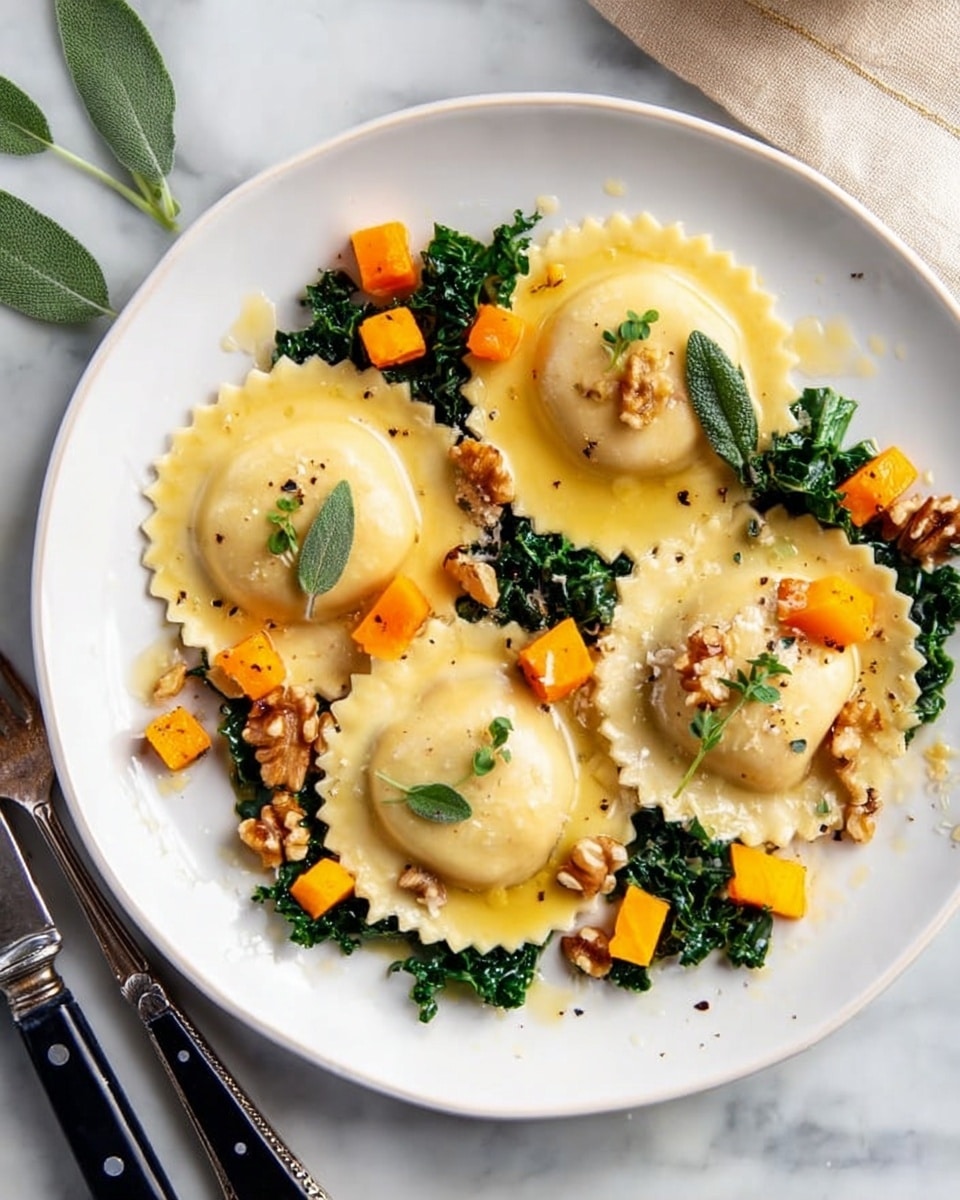
Garnishes
I usually top these ravioli with extra chopped toasted walnuts for some crunch and a good dusting of freshly cracked black pepper. Sometimes, if I have it on hand, a little grated pecorino cheese adds a perfect salty tang that balances the sweet squash filling. Fresh sage leaves lightly crisped in olive oil also make a beautiful and tasty garnish that’s hard to resist.
Side Dishes
To round out the meal, I love serving sautéed kale or spinach alongside for a healthy green touch. A simple arugula salad dressed with lemon vinaigrette also feels fresh and bright with this rich pasta dish. If you’re feeling indulgent, garlic bread makes for an irresistible pairing to scoop up any leftover wine sauce on the plate.
Creative Ways to Present
For special occasions, I’ve arranged the ravioli in a circle on warm plates, drizzled the wine sauce over them artistically, and sprinkled edible flowers or microgreens for a restaurant-worthy look. You can also serve the filling as a stuffing inside a roasted butternut squash half for a stunning vegetarian main course alternative. Presentation is so much fun when you make the effort!
Make Ahead and Storage
Storing Leftovers
Leftovers of butternut squash ravioli can be stored in an airtight container in the refrigerator for up to 2 days. I recommend separating layers with parchment paper or lightly flouring the ravioli to prevent sticking. The wine sauce stores separately in a small jar and can be reheated gently before serving.
Freezing
This is a great make-ahead recipe because you can freeze the uncooked ravioli before boiling. Just arrange them on a parchment-lined tray so they don’t touch and freeze solid, then transfer to a sealed container or freezer bag for up to 1 month. When you want to cook them, drop them straight into boiling water—just add an extra minute or so to the cooking time.
Reheating
To reheat cooked ravioli leftovers, I recommend warming them gently in a skillet with a bit of butter or olive oil to avoid sogginess. You can also briefly microwave them covered, but they’re best when given a little pan time to revive their texture. Reheat the wine sauce separately and drizzle on top just before serving.
FAQs
-
Can I use store-bought pasta sheets instead of homemade for this recipe?
Absolutely! While homemade pasta makes a tender and fresh ravioli, high-quality fresh store-bought pasta sheets can be a great shortcut without sacrificing too much flavor or texture. Just ensure they’re soft enough to work with and dust well with flour to prevent sticking during assembly.
-
How do I prevent the ravioli from bursting when boiling?
To avoid bursting, make sure the ravioli seals are pressed firmly with no air pockets inside. Chilling the filled ravioli before boiling helps the filling set. Use a large pot with plenty of boiling salted water, and gently stir occasionally while cooking to keep them from sticking to each other or the pot.
-
Can I make the filling ahead of time?
Yes, the filling can be made a day ahead and stored tightly covered in the fridge. It actually tastes better after sitting as the flavors meld. Just take it out a bit before assembling so it softens slightly for easier scooping.
-
What wine is best for the sauce?
Use a dry white wine such as Sauvignon Blanc, Pinot Grigio, or Chardonnay for a light, crisp, and fruity flavor that complements the sage and garlic without overpowering the dish.
-
Is there a vegan version of this recipe?
You can easily make the filling vegan by omitting the pecorino cheese and either skipping the sauce cheese garnish or substituting with nutritional yeast. Make sure your pasta dough doesn’t contain eggs or swap with a vegan pasta dough recipe.
Final Thoughts
This Butternut Squash Ravioli with Sage Walnut Filling and Wine Sauce Recipe has become one of my go-to seasonal dishes whenever squash is in abundance. It’s such a joy to make from scratch, filling the kitchen with roasted aromas and herbal scents. I love how versatile it is—whether for a relaxed weekend or a special celebration—and how the homemade pasta really makes it feel like a labor of love. I hope you give it a try and find the same joy in crafting this cozy, elegant meal that I do.
Print
Butternut Squash Ravioli with Sage Walnut Filling and Wine Sauce Recipe
- Prep Time: 1 hour
- Cook Time: 1 hour
- Total Time: 2 hours
- Yield: 4 servings
- Category: Main Course
- Method: Baking
- Cuisine: Italian
- Diet: Vegetarian
Description
This Butternut Squash Ravioli recipe features tender homemade pasta filled with a smooth and flavorful roasted butternut squash mixture enhanced by sage, shallots, and walnuts. Served with a delicate garlic, sage, and white wine sauce, it offers a comforting and elegant dish perfect for fall or any special occasion.
Ingredients
For the Ravioli
- 1 small butternut squash
- Extra-virgin olive oil, for drizzling
- 1 medium shallot, roughly chopped (scant 1/2 cup)
- 3 garlic cloves, peeled
- 1/4 cup loose-packed fresh sage leaves
- 1 recipe Homemade Pasta
- 1/3 cup chopped walnuts
- 1 teaspoon apple cider vinegar
- Pinch nutmeg
- 3/4 teaspoon sea salt, plus more for sprinkling
- Freshly ground black pepper
For Serving
- 2 tablespoons extra-virgin olive oil
- 2 garlic cloves, thinly sliced
- 10 fresh sage leaves
- 2 tablespoons dry white wine
- 1 teaspoon fresh thyme leaves
- 1/4 teaspoon sea salt
- 1/4 cup chopped walnuts
- Freshly ground black pepper
- 1 cup roasted butternut squash cubes (optional)
- 1/2 bunch sautéed kale (optional)
- Grated pecorino cheese (optional)
Instructions
- Preheat and Roast: Preheat your oven to 400°F and line a baking sheet with parchment paper. Cut the butternut squash in half vertically and scoop out the seeds. Drizzle the squash with olive oil, sprinkle with salt and pepper, then place cut side-down on the baking sheet. Prick the skin with a fork several times and roast for 40 minutes. Meanwhile, wrap the shallot, garlic cloves, and sage in foil with olive oil and salt, and roast for 20 minutes. Allow all roasted items to cool for at least 30 minutes.
- Make Pasta Dough: Prepare homemade pasta dough according to your preferred recipe. Once made, wrap the dough ball in plastic wrap and let it rest while you prepare the filling.
- Prepare Filling: Pulse the walnuts in a food processor until finely ground. Add the roasted shallot, garlic, and sage to the processor. Measure 1½ packed cups of roasted butternut squash and add it to the mixture. Then add apple cider vinegar, nutmeg, sea salt, and freshly ground black pepper. Pulse until very smooth. Chill the filling until ready to assemble.
- Roll and Assemble Ravioli: Roll out the pasta sheets skipping the folding step, stopping after you have thin sheets. Lay four pasta sheets on a floured surface. Use a 1-tablespoon cookie scoop to drop filling evenly spaced on two sheets. Cover with the remaining two sheets and gently press around the filling to seal. Use a ravioli stamp or cutter to cut out ravioli shapes.
- Cook Ravioli: Bring a pot of salted water to a boil and cook the ravioli for 4 minutes until tender and cooked through. Cook the ravioli just as you start preparing the sauce to coordinate timing.
- Prepare Sauce: Heat olive oil in a medium skillet over medium heat. Add sliced garlic and sage leaves, cooking for 3 minutes until fragrant. Stir in the white wine, fresh thyme, and sea salt; cook for another 2 minutes until slightly reduced.
- Serve: Spoon the sauce over drained ravioli and sprinkle with chopped toasted walnuts and freshly ground black pepper. Optionally, add roasted butternut squash cubes, sautéed kale, and grated pecorino cheese for extra richness and texture.
Notes
- Be sure to let the roasted squash and aromatics cool completely before blending the filling to achieve a smooth texture.
- Resting the pasta dough is essential for easier rolling and better texture.
- Use a ravioli stamp or cutter to ensure even portion sizes and properly sealed ravioli.
- Optional garnishes like roasted squash cubes, kale, and pecorino add layers of flavor and variety.
- For a vegan option, omit pecorino cheese or substitute with a plant-based alternative.
Nutrition
- Serving Size: 1 serving (about 6 ravioli pieces)
- Calories: 450 kcal
- Sugar: 5 g
- Sodium: 350 mg
- Fat: 22 g
- Saturated Fat: 3 g
- Unsaturated Fat: 18 g
- Trans Fat: 0 g
- Carbohydrates: 50 g
- Fiber: 6 g
- Protein: 10 g
- Cholesterol: 0 mg

